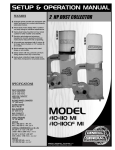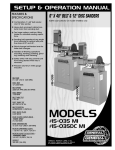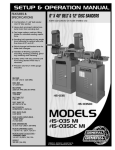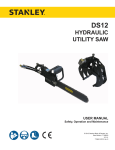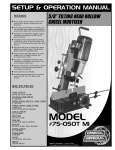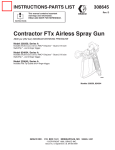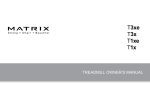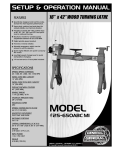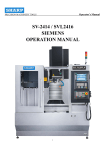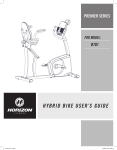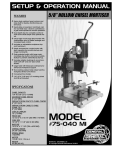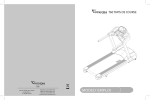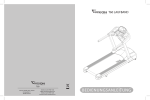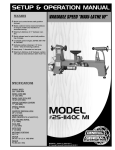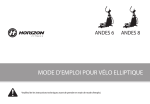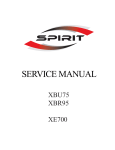Download General International 30-120 M1 Use and Care Manual
Transcript
SETUP & OPERATION MANUAL FEATURES 7” MOLDER Cast-iron table and head for smooth vibration free performance. Heavy-duty cast-iron dovetailed column, precision machined for smooth cutter head height adjustment. Precision high-speed, sealed, pre-lubricated bearings. Independent, variable speed feed motor provides added control for precision, tearout free performance with hardwoods and stock with figured grain. Jackscrew style cutter head adjustment system. Triple guide bearing design allows for curved moldings Easily adjustable guide fence system; simple lock knob design, to keep stock in-line through the cut. In-feed and out-feed table extension rollers, for added support with longer workpieces. Magnetic 2-step safety switch to prevent unwanted or unintentional start-up is equipped with an extra-large easy access stop panel and a lock-out key to prevent unauthorized use of the molder. Built-in dust hood with 4” dust outlet. Variable feed speed. SPECIFICATIONS MAXIMUM PLANING WIDTH 7” (178 MM) MAXIMUM MOLDING WIDTH 6 3⁄4” (171 mm) MAXIMUM THICKNESS OF STOCK 8” (203 mm) MINIMUM THICKNESS OF STOCK 1⁄4” (6 mm) MINIMUM LENGTH OF STOCK 8” (203 mm) MAXIMUM DEPTH OF CUT (PLANING) 1⁄8” (3 mm) MAXIMUM DEPTH OF CUT (MOLDING) 3⁄4” (19 MM) NUMBER OF KNIVES 2 CUTTER HEAD SPEED 7000 RPM FEED SPEED (VARIABLE) 3 - 20 FPM (0.9 - 6.1 MPM) MOTOR 2 HP 220 V, 1 PH, 12 A OVERALL DIMENSIONS (L X W X H) 32” X 27 1⁄2” X 51” (813 X 699 X 1295 MM) WEIGHT 242 LBS (110 KG) MODEL #30-120 M1 REVISION 1 - MARCH 08/10 © Copyright General® International 03/2010 GENERAL® INTERNATIONAL 8360 Champ-d’Eau, Montreal (Quebec) Canada H1P 1Y3 Telephone (514) 326-1161 • Fax (514) 326-5555 • www.general.ca THANK YOU for choosing this General® International model 30-120 M1 7” Molder. This molder has been carefully tested and inspected before shipment and if properly used and maintained, will provide you with years of reliable service. For your safety, as well as to ensure optimum performance and trouble-free operation, and to get the most from your investment, please take the time to read this manual before assembling, installing and operating the unit. The manual’s purpose is to familiarize you with the safe operation, basic function, and features of this molder as well as the set-up, maintenance and identification of its parts and components. This manual is not intended as a substitute for formal woodworking instruction, nor to offer the user instruction in the craft of woodworking. If you are not sure about the safety of performing a certain operation or procedure, do not proceed until you can confirm, from knowledgeable and qualified sources, that it is safe to do so. Once you’ve read through these instructions, keep this manual handy for future reference. Disclaimer: The information and specifications in this manual pertain to the unit as it was supplied from the factory at the time of printing. Because we are committed to making constant improvements, General® International reserves the right to make changes to components, parts or features of this unit as deemed necessary, without prior notice and without obligation to install any such changes on previously delivered units. Reasonable care is taken at the factory to ensure that the specifications and information in this manual corres- ponds with that of the unit with which it was supplied. However, special orders and “after factory” modifications may render some or all information in this manual inapplicable to your machine. Further, as several generations of this model of molder and several versions of this manual may be in circulation, if you own an earlier or later version of this unit, this manual may not depict your machine exactly. If you have any doubts or questions contact your retailer or our support line with the model and serial number of your unit for clarification. GENERAL® & GENERAL® INTERNATIONAL WARRANTY All component parts of General®, General® International and Excalibur by General International ® products are carefully inspected during all stages of production and each unit is thoroughly inspected upon completion of assembly. Limited Lifetime Warranty Because of our commitment to quality and customer satisfaction, General® and General® International agree to repair or replace any part or component which upon examination, proves to be defective in either workmanship or material to the original purchaser for the life of the tool. However, the Limited Lifetime Warranty does not cover any product used for professional or commercial production purposes nor for industrial or educational applications. Such cases are covered by our Standard 2-year Limited Warranty only. The Limited Lifetime Warranty is also subject to the “Conditions and Exceptions” as listed below. Standard 2-Year Limited Warranty All products not covered by our lifetime warranty including products used in commercial, industrial and educational applications are warranted for a period of 2 years (24 months) from the date of purchase. General® and General® International agree to repair or replace any part or component which upon examination, proves to be defective in either workmanship or material to the original purchaser during this 2-year warranty period, subject to the “conditions and exceptions” as listed below. To file a Claim To file a claim under our Standard 2-year Limited Warranty or under our Limited Lifetime Warranty, all defective parts, components or machinery must be returned freight or postage prepaid to General® International, or to a nearby distributor, repair center or other location designated by General® International. For further details call our service department at 1-888949-1161 or your local distributor for assistance when filing your claim. Along with the return of the product being claimed for warranty, a copy of the original proof of purchase and a “letter of claim” must be included (a warranty claim form can also be used and can be obtained, upon request, from General® International or an authorized distributor) clearly stating the model and serial number of the unit (if applicable) and including an explanation of the complaint or presumed defect in material or workmanship. CONDITIONS AND EXCEPTIONS: This coverage is extended to the original purchaser only. Prior warranty registration is not required but documented proof of purchase i.e. a copy of original sales invoice or receipt showing the date and location of the purchase as well as the purchase price paid, must be provided at the time of claim. Warranty does not include failures, breakage or defects deemed after inspection by General® or General® International to have been directly or indirectly caused by or resulting from; improper use, or lack of or improper maintenance, misuse or abuse, negligence, accidents, damage in handling or transport, or normal wear and tear of any generally considered consumable parts or components. Repairs made without the written consent of General® Internationallwill void all warranty. TABLE OF CONTENTS Rules for safe operation . . . . . . . . . . . . . . .5 Electrical requirements . . . . . . . . . . . . . . .6 Grounding instructions . . . . . . . . . . . . . . . . . . . . . . .6 Circuit capacity . . . . . . . . . . . . . . . . . . . . . . . . . . . . .6 Extension cords . . . . . . . . . . . . . . . . . . . . . . . . . . . . .6 Identification of main parts and components . . . . . . . . . . . . . . . . . . . .7 Checking/Setting the knives for planing 13-15 Setting one knife parallel to the table . . . . . . . . .14 Setting the height of the second knife . . . . . . . . .15 Adjusting the feed rollers . . . . . . . . . . .16-17 Adjusting the feed roller height . . . . . . . . . . . . . . .16 Adjusting the feed roller pressure . . . . . . . . . . . . .17 To install molding knives . . . . . . . . . . . . .18 Operating instructions . . . . . . . . . . . . .20-24 Unpacking . . . . . . . . . . . . . . . . . . . . . . . . .8 List of contents . . . . . . . . . . . . . . . . . . . . . . . . . . . . . .8 Additional requirements for set up . . . . . . . . . . . . .8 Placement within the shop / Establishing a safety zone . . . . . . . . . . . . .9 Basic principles of planing/molding . . . . . . . . . .20 Selecting boards suitable for planing/molding .20 Rated limits of this molder/planer . . . . . . . . . . . . .20 Connecting to a dust collector . . . . . . . . . . . . . . .21 Checklist before starting . . . . . . . . . . . . . . . . . . . . .21 Planing . . . . . . . . . . . . . . . . . . . . . . . . . . . . . . . . . . .22 Molding . . . . . . . . . . . . . . . . . . . . . . . . . . . . . . . . . . .23 Repeat/multiple passes (for planing & molding) .23 Molding curved pieces using the elliptical jig . .24 Preparation & Clean up . . . . . . . . . . . . . . . .9 Install the cutter head height adjustment handwheel . . . . . . . . . . . . . . . . . . . . . . . . . . . . . . . . .9 Remove the styrofoam block . . . . . . . . . . . . . . . . . .9 Remove the protctive plastic sheet . . . . . . . . . . . . .9 Clean up . . . . . . . . . . . . . . . . . . . . . . . . . . . . . . . . . .10 Maintenance . . . . . . . . . . . . . . . . . . . .25-19 Periodic maintenance . . . . . . . . . . . . . . . . . . . . . .25 Drive chain/gear lubrication . . . . . . . . . . . . . . . . .26 Inspecting/replacing cutte head knives . . . . . . .26 Recommended optional accessories . . . . .27 Assembly instructions . . . . . . . . . . . . . . .10 Mount the magnetic safety switch . . . . . . . . . . . .10 Attach the leveling feet to the stand . . . . . . . . . . .10 Install the belt on the drive pulley . . . . . . . . . . . . .10 Basic adjustments & controls . . . . . . . .11-13 Raising/Lowering the cutter head for depth of cut . . . . . . . . . . . . . . . . . . . . . . . . . . . . . . .11 Connecting to a power source . . . . . . . . . . . . . . .12 On/off power switches . . . . . . . . . . . . . . . . . . . . . .12 On/off magnetic power switch . . . . . . . . . . . . . . .12 Feed motor switch with safety key . . . . . . . . . . . .12 Thermal relay/circuit breaker . . . . . . . . . . . . . . . .13 Changing feed speed . . . . . . . . . . . . . . . . . . . . . .13 Parts list & diagrams . . . . . . . . . . . . . .28-34 RULES FOR SAFE OPERATION To help ensure safe operation, please take a moment to learn the machine’s applications and limitations, as well as potential hazards. General® International disclaims any real or implied warranty and holds itself harmless for any injury that may result from improper use of its equipment. 1. Do not operate this molder when tired, distracted, or under the effects of drugs, alcohol or any medication that impairs reflexes or alertness. 13. Do not push or force stock into the cutter head. The molder will perform better and safer when working at the rate for which it was designed. 2. The working area should be well lit, clean and free of debris. 14. Kickback is when the workpiece is ejected at high speeds by the force of the cutter head. To minimize the risk of injury from kickback, use proper feeding technique and stand to one side, out of the path of a potential kickback. 3. Keep children and visitors at a safe distance when the molder is in operation; do not permit them to operate the molder. 4. Childproof and tamper proof your shop and all machinery with locks, master electrical switches and switch keys, to prevent unauthorized or unsupervised use. 5. Stay alert! Give your work your undivided attention. Even a momentary distraction can lead to serious injury. 6. Fine particulate dust is a carcinogen that can be hazardous to health. Work in a well-ventilated area and whenever possible use a dust collector. Wear face, eye, ear, respiratory and body protection devices. 7. Do not wear loose clothing, gloves, bracelets, necklaces or other jewelry while the molder is in operation. Wear protective hair covering to contain long hair and wear non-slip footwear. 8. Be sure that adjusting wrenches, tools, drinks and other clutter are removed from the machine and/or the table surface before operating. 9. Keep hands well away from knives and all moving parts. Use a push stick to feed stock, and a brush, not hands, to clear away chips and dust. 10. Be sure that the knives are securely installed in the cutter head. 11. Always use clean, properly sharpened knives. Dirty or dull knives are unsafe and can lead to accidents. 12. Inspect stock and remove all foreign objects before planing. Make sure that any stock you plane is clean and free of any dirt, nails, staples, tiny rocks or any other foreign objects that may damage the molder knives. Only process natural solid wood boards. Never plane MDF, particle board, plywood, laminates or other synthetic materials. 15. Select appropriate feed speed for the stock being planed: high speed for softwood and slow for hardwoods. 16. Place stock firmly against the table and use suitable in-feed and out-feed support if stock is too long. 17. Keep guards in place and in working order. If a guard must be removed for maintenance or cleaning make sure it is properly attached before using the machine again. 18. Use of parts and accessories NOT recommended by GENERAL®INTERNATIONAL may result in equipment malfunction or risk of injury. 19. Never stand or lean on machinery. Serious injury could result if the tool is tipped over or if the cutting tool is unintentionally contacted. 20. Always disconnect the tool from the power source before servicing or changing accessories such as knives, or before performing any maintenance or cleaning, or if the machine will be left unattended. 21. Make sure that the switch is in the “OFF” position before plugging in the power cord. 22. Make sure the tool is properly grounded. If equipped with a 3-prong plug it should be used with a three-pole receptacle. Never remove the third prong. 23. Do not use this molder for other than its intended use. If used for other purposes, GENERAL® INTERNATIONAL disclaims any real implied warranty and holds itself harmless for any injury, which may result from that use. 5 ELECTRICAL REQUIREMENTS BEFORE CONNECTING THE MACHINE TO THE POWER SOURCE, VERIFY THAT THE VOLTAGE OF YOUR POWER SUPPLY CORRESPONDS WITH THE VOLTAGE SPECIFIED ON THE MOTOR I.D. NAMEPLATE. A POWER SOURCE WITH GREATER VOLTAGE THAN NEEDED CAN RESULT IN SERIOUS INJURY TO THE USER AS WELL AS DAMAGE TO THE MACHINE. IF IN DOUBT, CONTACT A QUALIFIED ELECTRICIAN BEFORE CONNECTING TO THE POWER SOURCE. THIS TOOL IS FOR INDOOR USE ONLY. DO NOT EXPOSE TO RAIN OR USE IN WET OR DAMP LOCATIONS. EXTENSION CORDS C A B GROUNDING INSTRUCTIONS In the event of an electrical malfunction or short circuit, grounding reduces the risk of electric shock to the operator. The motor of this machine is wired for 220V single phase operation and is equipped with a 3-conductor cord A and a 3-prong grounded plug B to fit a matching grounding type receptacle C. The use of an extension cord is not generally recommended for 220V equipment. If you find it necessary, use only 3-wire extension cords that have 3-prong grounding plug and a matching 3-pole receptacle that accepts the tool’s plug. Repair or replace a damaged extension cord or plug immediately. If you find it necessary to use an extension cord with your machine make sure the cord rating is suitable for the amperage listed on the motor I.D. plate. An undersized cord will cause a drop in line voltage resulting in loss of power and overheating. The accompanying chart shows the correct size extension cord to be used based on cord length and motor I.D. plate amp rating. If in doubt, use the next heavier gauge. The smaller the number, the heavier the gauge. TABLE - MINIMUM GAUGE FOR CORD TOTAL LENGTH OF CORD IN FEET AMPERE RATING <5 DO NOT MODIFY THE PLUG PROVIDED ! If it will not fit your recepta- cle, have the proper receptacle installed by a qualified electrician. CHECK with a qualified electrician or service person if you do not completely understand these grounding instructions, or if you are not sure the tool is properly grounded. CIRCUIT CAPACITY Make sure that the wires in your circuit are capable of handling the amperage draw from your machine, as well as any other machines that could be operating on the same circuit. If you are unsure, consult a qualified electrician. If the circuit breaker trips or the fuse blows regularly, your machine may be operating on a circuit that is close to its amperage draw capacity. However, if an unusual amperage draw does not exist and a power failure still occurs, contact a qualified technician or our service department. 6 6 TO 10 10 TO 12 12 TO 16 220 VOLTS 25 FEET -------> -------> -------> -------> 50 FEET 100 FEET 150 FEET 18 AWG 16 16 14 18 16 14 12 16 16 14 12 14 12 * NR * NR * NR = Not Recommended 7” MOLDER 30-120 M1 IDENTIFICATION OF MAIN PARTS AND COMPONENTS A C B D F G G E E I H J M k L N O A- CUTTER HEAD HEIGHT ADJUSTMENT HANDWHEEL H- FEED SPEED CONTROL KNOB B- BELT COVER J- THERMAL RELAY C- DUST HOOD K- DRIVE MOTOR D- FEED MOTOR L- MAGNETIC SWITCH WITH LOCK-OUT KEY E- TABLE EXTENSION ROLLERS M- DRIVE MOTOR COVER PANEL F- FENCES N- STAND G- FENCE LOCK KNOBS O- LEVELING FOOT I- FEED MOTOR SWITH WITH SAFETY KEY 7 UNPACKING Carefully unpack and remove the molder and its components from the box and check for damaged or missing items as per the list of contents below. NOTE: Please report any damaged or missing items to your General International distributor immediately. LIST OF CONTENTS A QTY A- MOLDER .........................................................................1 B- HANDWHEEL ..................................................................1 LEVELING FOOT & HARDWARE: C - HEX NUT .........................................................................8 D - FLAT WASHER ............................................... .................8 E - LEVELING FOOT .............................................................4 ELLIPTICAL JIG & HARDWARE: FGHIJ- ELLIPTICAL JIG................................................................1 IDLER BEARING ..............................................................1 CAP SCREW M8 X 1.25 - 110L .....................................2 WASHER..........................................................................2 BUTTON HEAD SCREW M6 X 1.0 - 16L. ........................2 TOOLS KLMNOPQRS- SCREWDRIVER ...............................................................1 17-19 MM OPEN END WRENCH ..................................1 12-14 MM OPEN END WRENCH ..................................1 7-8 MM OPEN END WRENCH ......................................1 6 MM OPEN END WRENCH .........................................1 6 MM ALLEN KEY ..........................................................1 4 MM ALLEN KEY ..........................................................1 2 MM ALLEN KEY ...........................................................1 4 MM T-HANDLE WRENCH.............................................1 B F C H G D C E I J ADDITIONAL REQUIREMENTS FOR SET UP • Extra person for help with lifting • Feeler gauge set (0.030”) • 3 mm Allen key • Gauge block K L M T N O P 8 Q R PLACEMENT WITHIN THE SHOP / ESTABLISHING A SAFETY ZONE THIS MODEL 30-120 M1 7” MOLDER IS HEAVY. DO NOT OVER-EXERT. THE HELP OF AT LEAST ONE ASSISTANT OR A HOIST WILL BE NEEDED FOR THE FOLLOWING STEP. TO LIMIT THE RISK OF SERIOUS INJURY OR DAMAGE TO THE MACHINE, ANY EQUIPMENT USED TO LIFT THIS MACHINE SHOULD HAVE A RATED CAPACITY IN EXCESS OF 242 LBS (110 KG). PLACEMENT WITHIN THE SHOP This machine should be installed and operated only on a solid, flat and stable floor that is able to support the weight of the molder and the operator. Using the dimensions shown as a guideline, plan for placement within your shop that will allow the operator to work unencumbered and unobstructed by foot traffic (either passing shop visitors or other shop workers) or other tools or machinery. 51” 32” ESTABLISHING A SAFETY ZONE For shops with frequent visitors or multiple operators, it is advisable to establish a safety zone around shop machinery. A clearly defined “no-go” zone on the floor around each machine can help avoid accidents that 27 1/2 ” could cause injury to either the operator or the shop visitor. It is advisable to take a few moments to either paint (using non-slip paint) or using tape, define on the floor the limits or perimeter of each machines safety zone. Take steps to ensure that all operators and shop visitors are aware that these areas are off limits whenever a machine is running for everyone but the individual operating the unit. PREPARATION & CLEAN UP INSTALL THE CUTTER HEAD HEIGHT ADJUSTMENT HANDWHEEL A REMOVE THE STYROFOAM BLOCK B D C E To limit the potential for damage in transport, this molder is shipped from the factory with the molder’s head sitting on a styrofoam block for support. 1. Using a 3 mm Allen key, loosen the set screw A on the handwheel. 2. Fit the handwheel shaft onto the shaft, B. 3. Tighten the set screw C to secure the handwheel in place. 1. Loosen the cutter head lock lever D by turning it counterclockwise. Important! Attempting to adjust the height of the cutter head with it’s lock lever tightened will cause premature wear of the locking mechanism. 2. Rotate the handwheel counterclockwise to raise the cutter head enough to remove the styrofoam block E. REMOVE THE PROTECTIVE PLASTIC SHEET 1. Loosen the fence lock knobs F and remove the fences G and H. 2. Remove the protective plastic sheet I from the table. H G F I 9 CLEAN UP The protective coating on the table, K, prevents rust from forming during shipping and storage. Remove it by rubbing with a rag dipped in kerosene, mineral spirits or paint thinner. K Important: Dispose of potentially flammable solventsoaked rags according to manfacturer’s safety recommendations. A putty knife, held flat to avoid scratching the surface, may also be used to scrape off the coating followed by clean-up with solvent. Note: Avoid rubbing the molder’s painted surfaces, as many solvent-based products will remove paint. Tip: To prevent rust, apply a light coating of paste wax or use regular applications of any after-market surface protectant or rust inhibitor. ASSEMBLY INSTRUCTIONS For your convenience this molder is shipped from the factory partially assembled and requires only minimal assembly and set up before being put into service. MOUNT THE MAGNETIC SAFETY SWITCH B SERIOUS PERSONAL INJURY COULD OCCUR IF YOU CONNECT THE MACHINE TO THE POWER SOURCE BEFORE YOU HAVE COMPLETED THE INSTALLATION AND ASSEMBLY STEPS. DO NOT CONNECT THE MACHINE TO THE POWER SOURCE UNTIL INSTRUCTED TO DO SO. A Attach the magnetic safety swith to the right side of the molder using the 2 button head screws already mouned to the stand A as shown in B. ATTACH THE LEVELING FEET TO THE STAND INSTALL THE BELT ON THE DRIVE PULLEY CLOSE UP B C A E D Attach the 4 leveling feet A to the stand using 2 nuts B and 2 washers C in the assembly order shown in D. Note: After the stand is placed in its final location, level the feet by loosening the top nut, adjusting lower nut up or down on the screw stem as needed, then tightening down the top nut. 10 E Note: To limit the potential for damage in transport, this molder is shipped from the factory with the motor mounting plate secured to the stand with a cap screw E. 1. Using the supplied 6 mm allen key, loosen and remove the cap screw and flat washer E that secures the motor mounting plate to the stand. H F F I G I I I F 2. Using the supplied 4 mm T-handle wrench, loosen and remove the 3 Allen screws F, then remove the upper pulley cover G. 3. Using the supplied 4 mm T-handle wrench, unscrew and remove the 4 button head screws I that secure the motor cover panel to the stand. Note: The drive belt is already installed on the upper pulley H . J K 4. Remove the motor cover panel to access the motor J. 5. With the help of an assistant, lift the motor up and install the other end of the belt in the slot on the lower pulley K. 6. Re-install the motor cover panel and upper pulley cover. BASIC ADJUSTMENTS & CONTROLS RAISING/LOWERING THE CUTTER HEAD FOR DEPTH OF CUT The depth of cut is set by raising or lowering the cutter head. B DOWN UP C A A 1/3 x 1. = 1/32” Loosen the cutter head lock lever A by turning it counterclockwise. Important! Attempting to adjust the height of the cutter head with it’s lock lever tightened will cause premature wear of the locking mechanism. 2. Use handwheel B to adjust the cutter head height to the desired depth of cut, turning: - Clockwise to raise the cutter head. - Counterclockwise to lower the cutter head. Note: the depth gauge, C, on the front of the machine can be used as a reference but it is not intended for high precision measurements 3. Re-tighten lock lever A to secure the cutter head in position. NOTE: 1/3 of a clockwise rotation of the crank handle will raise the cutter head by 1/32”. 1/3 of a counterclockwise rotation will lower the cutter head by 1/32”. 11 CONNECTING TO A POWER SOURCE TO REDUCE THE RISK OF SHOCK OR FIRE DO NOT OPERATE THE UNIT WITH A DAMAGED POWER CORD OR PLUG. REPLACE DAMAGED CORD OR PLUG IMMEDIATELY. SWITCHES OFF TO AVOID UNEXPECTED OR UNINTENTIONAL START-UP, MAKE SURE THAT BOTH OF THE POWER SWITCHES ARE IN THE OFF POSITION BEFORE CONNECTING TO A POWER SOURCE. Once the assembly steps have been completed, uncoil the power cord and plug the power cord into an appropriate outlet. Refer back to the section entitled “Electrical Requirements” and make sure all requirements and grounding instructions are followed. When operations have been completed unplug the molder from the power source. ON/OFF POWER SWITCHES This molder is equipped with 2 different ON/OFF power switches: one magnetic switch equipped with a lock-out key for the drive motor and one independant on/off switch with a safety key and thermal /re-set breaker for the feed motor. TO PREVENT UNAUTHORIZED USE OR UNINTENTIONAL START-UP, REMOVE THE SAFETY KEY AND LOCK-OUT KEY AND STORE THEM IN A SAFE PLACE, OUT OF THE REACH OF CHILDREN, WHENEVER THE MOLDER IS NOT IN USE. ON/OFF MAGNETIC POWER SWITCH This model 30-120 M1 is equipped with a Magnetic 2-step safety switch to prevent unwanted or unintentional start-up and unauthorized use of the planer/molder. A The switch assembly is equipped with a GREEN “START” button A, an extra-large easy access RED stop panel B, and a lock-out key C. B C To start the molder: Insert the lock-out key C and press on the GREEN “START” button A. To stop the molder: Press on the RED “STOP” panel, B. Once the RED “STOP” panel has been pressed, the planer/molder can only be started by pressing once again on the RED “STOP” panel to release the green button, then by pressing on the green button. FEED MOTOR SWITCH WITH SAFETY KEY G D H F E SAFETY KEY* ON OFF This model 30-120 M1 is also equiped with a simple ON / To start the feed motor: insert the safety key F and lift OFF switch ,D, for the feed motor, featuring a removable the switch up, G. lock out safety key E. To stop the feed motor: push down on the switch H. 12 THERMAL RELAY / CIRCUIT BREAKER TO AVOID UNEXPECTED OR UNINTENTIONAL START-UP BE CERTAIN THAT THE SWITCH HAS BEEN SET TO THE OFF POSITION BEFORE RE-SETTING THE THERMAL RELAY. SWITCH OFF The thermal relay (circuit breaker) protects the feed motor from power surges or spikes in line voltage. In the event of a power surge, the thermal relay will be automatically tripped thereby cutting off the power to the feed motor. I To reset the thermal relay after it has been tripped: set the feed motor switch to the “off” position and press the thermal relay re-set button I, then restart the feed motor. CHANGING FEED SPEED The feed motor speed ranges from 3 to 20 FPM (Feet Per minute). The feed speed adjustment knob is located on the feed motor control panel, on the right hand side of the machine. Turn the knob: Decrease speed Increase speed - Clockwise to increase the feed rate. - Counterclockwise to decrease the feed rate. Select appropriate feed speed for the stock being planed/molded: high speed for softwood and slow for hardwoods. Experiment with feed speeds based on the workpiece material and its width as well as the depth of cut, to find which setting work best for your needs. As a general guideline however, for best results more aggressive cuts or wider materials should be planed at slower speeds and lighter cuts or narrow materials can be planed at higher speeds. CHECKING / SETTING THE KNIVES FOR PLANING Accurate results can only be achieved when the two knives are properly installed and set to the exact same height in the cutter head. The planer knives have been factory set to the exact same height in the cutter head. However we suggest that you verify the knives prior to first use. To verify if the knives are set properly, use a gauge block* (not included) following the steps below for each knives: *Gauge block You may use a home made gauge block made of hardwood. The gauge block can be made by following the dimensions in A. A If you prefer, precision aluminum gauge blocks are available from General International under item #30-040. 13 ALWAYS DISCONNECT THE MACHINE FROM THE POWER SOURCE BEFORE MAKING ANY ADJUSTMENTS. FAILURE TO HEED THIS WARNING CAN LEAD TO SERIOUS PERSONAL INJURY. KNIVES ARE VERY SHARP. USE CARE WHEN HANDLING KNIVES. B C D C C 1. Make sure that the the machine is disconnected from the power source. 3. Turn the upper pulley D by hand, until any one of the knives is at it’s lowest point. 2. To give yourself unimpeded access to the cutter head and knives, remove the top cover B, by loosening and removing the 3 screws C. E F H DOWN UP G 4. Place your gauge block onto the table, under one extremity of the cutter head as shown in E and F. SETTING ONE KNIFE PARALLEL TO THE TABLE 5. Loosen the cutter head lock lever G by turning it counterclockwise, then lower or raise the cutter head as needed until the knife lightly touches the top of the gauge block as shown in H when you manually rock the cutter head back and forth. 6. Tighten the cutter head lock lever G to secure the cutter head in position. UNDERSIDE VIEW I 7. Place your gauge block onto the table, under the other extremity of the cutter head to check for knife parallelism with the table. Should the knife not be set properly follow next steps. If the knife is parallel to the table, skip ahead to step 15. 14 J 8. Turn the upper pulley by hand until you can fit the supplied T-handle wrench into the holes in the cutter head shaft as shown in I and J to keep the cutter head from turning. M K N N L 9. Loosen the 3 button head screws K using the supplied 4 mm T-handle wrench and draw the chip deflector away L from the cutter head as shown, then secure it in position. 11. Loosen the nut O located on top of the knife (the one on the side of the knife that need to be adjusted), then adjust the set screw P to raise or lower the knife until it lightly touches the top of the gauge block. 12. Re-tighten nut O then re-check the height setting on the other extremity of the knife and re-set if necessary until the knife is parallel to the table. 10. Fully loosen the 2 middle locking bolts M using the supplied 14 mm wrench, then slightly loosen the end locking bolts N, so that they still hold the knife. P O 13. Re-tighten the locking bolts M and N. SETTING THE HEIGHT OF THE SECOND KNIFE UNDERSIDE VIEW 14. Remove the T-handle wrench from the cutter head, rotate the head 180° and re-install the wrench to lock the opposite side of head in place. 15. Place your gauge block onto the table, under one extremity of the second knife. If the second knife is set higher or lower than the first knife, follow steps 10 and 11. 16. Place your gauge block under the other extremity of second knife and check for knife parallelism with the table. Should the knife not be set properly follow steps 11 to 13. If the second knife is parallel to the table, re-tighten nut O and locking bolts M and N. 15 ADJUSTING THE FEED ROLLERS ADJUSTING THE FEED ROLLER HEIGHT The feed rollers have been factory set at 0.030" below the lowest point of the knives. However we recommend that you verify that the feed rollers are properly set prior to first use. Important! Always verify that the two knives are properly installed and set to the exact same height in the cutter head before checking and adjusting the height of the feed rollers. FAILURE TO FOLLOW THESE RECOMMENDATIONS WILL LEAD TO POTENTIAL SERIOUS INJURY CAUSED BY STOCK KICKBACK. Make sure that the feed rollers are set 0.030 inches below the lowest point of the cutter knives as shown in A so that they can “grip” the board. If the feed rollers are set higher than the lowest point of the knives as shown in B, they won’t be able to grip the workpiece which will be ejected at high speeds by the force of the cutter head. cutter head A Out-feed roller B In-feed roller 0.030" ALWAYS DISCONNECT THE MACHINE FROM THE POWER SOURCE BEFORE MAKING ANY ADJUSTMENTS. FAILURE TO HEED THIS WARNING CAN LEAD TO SERIOUS PERSONAL INJURY. TO LIMIT THE POTENTIAL FOR INJURY FROM A KICKBACK, ALWAYS MAKE SURE THAT THE FEED ROLLERS ARE SET LOWER THAN THE LOWEST POINT OF THE CUTTER HEAD BEFORE ENGAGING A BOARD IN THE CUTTER HEAD. C D E Out-feed roller 16 In-feed roller 1. Place your gauge block on the table, under the cutter head. 3. Tighten the cutter head lock lever to secure the cutter head in position. 2. Place a 0.030" feeler gauge C on top of the gauge block, then lower the cutter head until the knife lightly touches the feeler gauge D when manually rocking the cutter head back and forth. 4. Place your gauge block on the table, under the infeed roller E. Out-feed roller F G In-feed roller H I 5. If needed, adjust the height of the in-feed roller by loosening the lock nuts F on the in-feed roller adjustment screws H and then turning adjustment screws G until the in-feed roller lightly touches the top of the gauge block, then re-tighten lock nuts F. 6. Place your gauge block onto the table, under the outfeed roller. If needed, adjust the height of the outfeed roller by loosening the lock nuts on the outfeed roller adjustment screws I and then turning the adjustment screws until the out-feed roller lightly touches the top of the gauge block, then re-tighten the lock nuts. Note: To avoid overtensionning the drive chains, which may result in drive chain breakage, do not lower the feed rollers too much. Use the number of threads on the adjustment screws as a visual reference. You should not count more than 5 threads on theses screws. If you have lowered the feed rollers to their lowest point and they still do not touch the top of the gauge block, you then will have to adjust the depth of cut to remove the thickness of material equivalent to the distance between the feed rollers and gauge block when the rollers are adjusted to their lowest point. FOR EXTENDED FEED ROLLER LIFE The infeed and outfeed rollers will have to be lowered for most molding operations. The amount of adjustment required will vary depending on the size and style of the cutter. For larger profiles and deeper cuts, re-adjust the height of the feed rollers after a few passes by loosening the screws G 2 turns (approx.) to correct the height of the rollers vs the depth of the stock that was removed from the workpiece. To prevent the top of the workpiece from damaging the feed rollers make sure that the workpiece never exceed 1/4" of the height of the rollers J. J Out-feed roller In-feed roller 3/4 1/2 1/4 Make sure the feed rollers are never set lower than this point ADJUSTING THE FEED ROLLER PRESSURE The feed rollers are factory set to provide a proper amount of downward pressure to the workpiece. However we recommend that you verify that the feed rollers are properly set prior to first use. K M L Then, with use and normal wear over time, it may periodically become necessary to make minor adjustments to pressure of the feed rollers. If you notice snipe (which is a small depression in the surface of a workpiece across its width either at one or both ends of your workpiece, the pressure on the feed rollers must be reduced. Refer to the following symptoms to determine which roller need to be adjusted: - If snipe occurs at the beginning of the board, reduce the amount of pressure on the in-feed roller by turning lock nut K on adjusting screws L counterclockwise. - If snipe occurs at the tail end of the board, reduce the amount of pressure on the out-feed roller by turning the lock nut K on adjusting screws M counterclockwise. NOTE: Some experimentation may be necessary to achieve an ideal adjustment. 17 TO INSTALL MOLDING KNIVES ALWAYS DISCONNECT THE MACHINE FROM THE POWER SOURCE BEFORE CHANGING KNIVES OR MAKING ANY ADJUSTMENTS. FAILURE TO HEED THIS WARNING CAN LEAD TO SERIOUS PERSONAL INJURY. KNIVES ARE VERY SHARP. USE CARE WHEN HANDLING KNIVES. UNDERSIDE VIEW A B C B D B 1. Make sure that the the machine is disconnected from the power source. 2. To give yourself unimpeded access to the cutter head and knives, remove the top cover A, by loosening and removing the 3 screws B. 3. Turn the upper pulley by hand until you can fit the supplied T-handle wrench into the holes in the cut ter head shaft as shown in C and D to keep the cut ter head from turning while changing knives. F E E E E 4. Using the supplied 14 mm wrench, loosen and remove all 4 locking bolts E. 5. Carefully remove the knife F. 6. Repeat steps 4 and 5 with the second knife on the opposite side of the cutter knife. H G I J 7. Clean any dust or wood chips from the cutter head G and knives, and carefullly store the knives in a safe and dry place if they will be re-used, or dispose of them safely if they are worn or damaged. 18 BEFORE INSTALLING MOLDING KNIVES, MAKE SURE THAT THE SET SCREWS DO NOT PROTRUDE FROM THE INNER FACE OF THE CUTTER HEAD AS SHOWN IN H (LETTER I SHOWS A PROTRUDING SET SCREW) AND THAT THE NUTS ARE FIRMLY FASTENED SO THAT THE KNIVES SIT FLUSH ONTO THE LIP. FAILURE TO HEED THIS WARNING CAN RESULT IN SERIOUS INJURIES AND/OR DAMMAGE TO THE MACHINE. 8. Place the molding knife against the cutter head lip with the beveled side of the knife facing up, J. K L 9. Use the holes in the cutter head that allow the knife to be installed as close to center as possible K and secure the knife in place with a bolt L in each of the mounting holes in the knife. Make sure the knife is sitting flush against the bottom lip and while tightening the bolts, apply light outward pressure against the knife to push it towards the pulley. 10. Place a perfectly squared block of wood (approx. 1” x 1” x 5”) on the table and against the right fence. 11. With the head positioned low enough, move the fence and the block over until the block touches the side of the knife and then lock the fence in place using both lock knobs. UNDERSIDE VIEW P O 12. Remove the T-handle wrench from the cutter head, rotate the head 180° and re-install the wrench to lock the opposite side of head in place. 13. Install the second molding knife using the same procedure in corresponding holes in the opposite side of the head. 14. To ensure that the second knife is aligned with the first, rotate the head 180° and verify that the side of knife lightly rubs against the block O. If needed, loosen the bolts P slightly and apply inward or outward pressure to the knife to reposition it as needed while retightening the bolts. L J H K 1/8” Min. 1/4” I K H 15. Loosen the 3 button head screws H on the flat chip deflector, then draw the chip deflector towards the cutter head I so there’s a space of roughly 1/8” between the chip deflector and knife edges J. 16. Rotate the head 180° 17. Loosen the 2 button head screws K on the curved chip deflector, then draw the chip deflector towards the cutter head so there’s a minimum space of 1/4” between the chip deflector and knife edges J. 19 OPERATING INSTRUCTIONS BASIC PRINCIPLES OF PLANING / MOLDING A This planer/molder is designed to remove material from the top face of a board in order to bring the board (or a series of boards) down to a specific desired shape or profile and thickness. To obtain uniform results across the length of a board, the stock being planed/molded must have one face that has already been machined perfectly flat (usually on a jointer) and the stock should be fed with this flat face against the table, A. SELECTING BOARDS SUITABLE FOR PLANING / MOLDING FLAT SIDE DOWN B ALWAYS PLANE / MOLD IN THE GENERAL DIRECTION OF THE GRAIN. PLANING/MOLDING AGAINST THE GRAIN OR PLANING END GRAIN IS DANGEROUS AND MAY CAUSE THE WORKPIECE TO SHATTER. This planer/molder is intended for use with solid woods or MDF only, and should not be used to plane or mold any other materials. The workpiece should always be fed through the machine in the general direction of the grain in the wood, B. Before being fed through the planer/molder all lumber should be inspected for debris and foreign objects such as staples or nails. Foreign objects stuck to, or embedded in your workpiece can be ejected from the machine at high speed and cause serious injury or damage cutter knives. Make sure to remove all such foreign objects from the wood before running it through the planer/molder. Select lumber carefully and avoid workpieces with loose or protruding knots. Workpieces that are twisted, severely deformed or warped should also be avoided. Warped, twisted, damaged or fragile stock runs an increased risk of jamming in or damaging the machine or cutters. There is also a much greater risk of injury to the operator or bystanders from kickback, where the workpiece is forcefully or violently ejected from the machine due to a jam, whenever working with such damaged or warped wood. RATED LIMITS OF THIS MOLDER / PLANER RESPECT THE RATED LIMITS OF THIS MACHINE IGNORING THESE LIMITS AND FEEDING NON COMPATIBLE STOCK INTO THIS MOLDER/PLANER CAN LEAD TO SERIOUS INJURY TO THE USER OR SHOP BYSTANDERS, AND CAUSE DAMAGE TO THE WORKPIECE AND/OR THE MACHINE. IF THE STOCK YOU WISH TO PLANE/MOLD DOES NOT MEET OR COMPLY WITH THE LIMITATIONS LISTED ABOVE, FIND ANOTHER SAFER WAY TO PERFORM THE REQUIRED TASK. MAXIMUM PLANING WIDTH: 7”. MAXIMUM MOLDING WIDTH: 6 3/4”. MAXIMUM WORKPIECE THICKNESS: 8” MINIMUM THICKNESS TO WHICH A WORKPIECE CAN BE SAFELY PLANED/MOLDED: 1/4” MINIMUM WORKPIECE LENGTH THAT CAN BE SAFELY PLANED: 8”. 20 MAXIMUM DEPTH OF CUT It is recommended that for both hard and soft wood: Removing less material per pass and taking multiple passes is always preferred to more aggressive planing/molding. Advantages include longer blade life, better finish quality (resulting in less time sanding later) and less likelihood of removing too much material causing the workpiece to be too thin for its intended use. Note: Depth of cut will vary depending on the width of the workpiece, density/type of wood and moisture content of the stock. REFERENCE CHART FOR DEPTH OF CUT SELECTION* WIDTH TYPE OF WOOD 1” Poplar MOLDING PLANING DEPTH OF CUT 1/4” or less 1/8” or less 1” Red Oak 3/16”or less 1/8” or less 3” White Pine 3/16” or less 1/8” or less 3” White Oak 1/8” or less 1/8” or less 6” Poplar 1/8” or less 1/8” or less 6” Red Oak 1/16” or less 1/8” or less *The information in this chart is supplied as a general guideline only. CONNECTING TO A DUST COLLECTOR A dust port with a 4” opening is provided to accommodate connection to a dust collector (not included). Be sure to use appropriate sized hose and fittings (not included) and check that all connections are sealed tightly to help minimize airborne dust. If you do not already own a dust collection system consider contacting your General® International distributor for information on our complete line of dust collection systems and accessories or visit our Web Site at www.general.ca CHECKLIST BEFORE STARTING A VERIFY ALL CHECK POINTS BEFORE STARTING. FAILURE TO COMPLY CAN RESULT IN SERIOUS INJURIES. • Make sure you and any assistants are wearing safe appropriate workshop attire. Roll up long sleeves, secure long hair and remove any jewelry: watches, rings, bracelets or anything that could become caught in the moving parts, potentially causing serious injury. • To reduce the risk of damage to the planer/molder or the workpiece, as well as a potential for personal injury, after initial set-up as well as before each use, make sure that everything is securely installed and that all fasteners and moving parts on this machine are locked in place before starting the machine. • Make sure that the knives in the cutter head are properly set as explained in section “Checking/Setting the knives for planing” or in section “To install molding knives”, depending on the intended use of the machine. • Make sure that the feed rollers are properly set as explained in section “Adjusting the feed rollers”. • Make sure the board has been inspected and is suitable for planing/molding as explained in section “Selecting boards suitable for planing/molding”. • If multiple boards are to be planed, collect all workpieces together and set them nearby on a table or bench within easy reach. To limit the potential for injury in the event of a kickback, avoid having to step or reach in front of the machine to pick up the next workpiece A. • Make sure to have on safety glasses as well as hearing & respiratory protection at all times when using the machine. 21 PLANING B DOWN UP A 1/3 x 1. With the planer turned off, position the workpiece on the table with the flat face down and the face to be planed facing up. 2. Position the fences A against each edge of the workpiece, without pinching the workpiece between the fences – make sure the workpiece can be fed between the fences without binding. = 1/32” Note: the depth gauge, B, can be used as a reference but it is not intended for high precision measurements 3. Slide the workpiece up to the cutter head and using the depth of cut adjustment handwheel, lower the cutter head as needed to obtain the desired depth of cut. 4. Set the board aside and tighten the cutter head locking lever C to lock the cutter head in position. 5. Turn on your dust collector. ALWAYS TURN ON THE DUST COLLECTOR BEFORE STARTING THE PLANER / MOLDER. C D E 6. Press the green "ON" button D on the magnetic switch to start the cutter head motor. 7. Set the feed speed to minimum before starting the feed motor, then lift the switch E up to start the feed motor. Gradually increase the speed, until you reach the desired feeding speed. KEEP HANDS AWAY FROM THE ROTATING CUTTER HEAD AND FEED ROLLERS. DO NOT FORCE THE WORKPIECE TOWARDS THE CUTTER HEAD – LET THE IN-FEED ROLLER FEED THE WORKPIECES. AVOID HAVING TO STEP OR REACH IN FRONT OF THE MACHINE. 8. Stand to one side of the machine and set the board back on the infeed table with the face to be planed facing up, aligning the board laterally so that it will be fed through the planer in the general direction of the grain 22 TO LIMIT THE POTENTIAL FOR INJURY IN THE EVENT OF A KICKBACK, AVOID STANDING DIR-ECTLY IN LINE WITH THE FRONT OR BACK OF THE MACHINE WHENEVER A BOARD IS ENGAGED IN THE CUTTER HEAD. 9. Slowly slide the workpiece forward until the in-feed roller “grips” the board. Release the board allowing the feed roller to automatically feed the board through the planer. 10. Step to the rear of the machine and recover the planed board on the table once it has cleared the out-feed roller and has stopped advancing. NEVER PUSH, PULL OR OTHERWISE TRY TO MOVE OR RE-POSITION THE WORKPIECE ONCE IT IS IN THE CONTROL OF THE AUTOMATIC FEED ROLLERS. MOLDING 1. Turn off and unplug the machine from the power source. A 2. - If only the face is to be profiled: Cut your workpiece to it’s final width. - If the edges are to be trimmed by the knives: Cut your workpiece to 1/32" wider than it’s final width. It is also recommended that all workpieces are planed to the final mold width and height before setting up the molder for any given profile. 3. Position the fences against each edge of the workpiece A, without pinching the workpiece between the fences – make sure the workpiece can be fed between the fences without binding. 4. Loosen the cutter head lock lever B and lower the cutter head until the knife barely makes contact with the workpiece. 5. Check that the workpiece is properly aligned with the knife and if needed adjust the fence positioning left or right to align the workpiece, then raise the cutter head just enough to remove the workpiece. 6. Adjust the cutter head downward by one full turn on the handwheel to take a 3/32” depth of cut. MAKE SURE THE PLANER / MOLDER HAS BEEN TURNED OFF AND UNPLUGGED FROM THE POWER SOURCE BEFORE PERFORMING ANY MAINTENANCE. C DOWN UP B 7. Proceed to steps 5 to 10 of previous section “Planing”. 1/3 x = 1/32” REPEAT/MULTIPLE PASSES (FOR PLANING AND MOLDING) In most cases several passes through the machine will be required to bring the workpiece(s) down to final thickness dimension or specific profile. In fact, it is generally preferable to remove less material per pass and achieve final thickness dimension/specific profile by taking multiple passes. This can extend blade life, place less strain on the motor and provide better workpiece finish quality that will require less time spent sanding later. Once all the boards have been passed through the machine once, set them aside and turn off the machine. Measure the workpiece(s) thickness / Inspect the profile, and if more material needs to be removed, repeat the steps of section “Planing” or “Molding” accordingly. Take as many passes as needed to achieve final workpiece thickness/profile, stopping the machine after each pass to reset the cutter head height, as well as the feed rollers height if needed. 23 MOLDING CURVED PIECES USING THE ELLIPTICAL JIG A The elliptical jig allows you to mold profiles into the face of curved workpieces. Molding curved workpieces generally requires the workpiece to be mounted and secured to a template that rides against the inner and outer guide bearings of the jig A. WORKPIECE For full width profile cuts, both the workpiece and the template must be of the exact same width as the top of the profile B. TEMPLATE B Note: this is not required when using a profile that is designed to cut only a portion of the entire width of the workpiece. Ideally, templates should be made from 3/4” thick MDF C and should be made roughly 4” longer than the workpiece at each end D. 4" 4" The minimum length of curved workpiece that can be safely molded is 9”. C To secure the workpiece to a template, pre-drill and counter sink mounting holes into the template from below E. The placement of the mounting holes will depend on the size of the workpiece and the shape of the curve as well as the profile and depth of cut required. 3/4" WORKPIECE TEMPLATE D D WORKPIECE TEMPLATE Use appropriate length flathead woodscrews, screwed into the workpiece from below to a minimum depth, and keep the final depth of the intended cut of the profile in mind to avoid having the molder knife contact the tips of the screw imbedded into the workpiece as the knives cut deeper into the workpiece from above F. Also make sure that the heads of the screws are seated below the countersink in the underside of the template to allow the template to slide flat against the table and avoid damaging or scratching the tables’ surface with an exposed screw head G. E F G ALWAYS EXERCISE EXTREME CAUTION WHEN RE-USING A TEMPLATE FOR A DIFFERENT PROFILE, AS A DIFFERENT LOCATION OF CUT AND DEPTH OF THE CUT IN THE WORKPIECE MAY REQUIRE RELOCATING THE MOUNTING SCREWS IN ORDER TO AVOID SCREW TIP CONTACT WITH THE KNIVES FROM ABOVE AS THEY CUT INTO THE WORKPIECE. 1. Turn off and unplug the machine from the power source. 2. If installed, remove the two fences. 3. If needed, raise the cutter head to give yourself unimpeded access to the table. H I J WORKPIECE TEMPLATE 24 4. Install the elliptical jig inner guide bearings as shown using 2 cap screws with washers H and install the outer idler guide bearing as shown using 2 button head screws I. 5. To align the guide bearings with the profile knife, lower the head to lightly pinch the workpiece J. 6. Loosen the jam nut K on the inner guide, turn the adjustment knob L to align the bearings with the knife and then tighten the jam nut to secure them in place. 7. With the workpiece flush against the inner guide bearings M, loosen the button head screws N on the outer idler guide bearing and adjust the bearing flush against the outside face of the workpiece O. Then tighten the screws to secure the bearing in place. K N L 8. In preparation for the first pass, raise the cutter head just enough to remove the workpiece, and then readjust the cutter head downward by one full turn on the handwheel to take than a 3/32” depth of cut. BEFORE STARTING THE MACHINE AND FEEDING THE WORKPIECE INTO THE CUTTER MAKE SURE THAT THERE IS NO INTERFERENCE IN THE KNIFE AREA THAT COULD CAUSE THE KNIVES TO MAKE CONTACT WITH ANYTHING OTHER THAN THE WORKPIECE. SERIOUS INJURY TO THE USER AND/OR BYSTANDERS AS WELL AS DAMAGE TO THE MACHINE, WORKPIECE AND KNIVES CAN OCCUR IF DURING THE MOLDING PROCESS, THE KNIVES COME INTO CONTACT WITH GUIDES, BEARINGS, SCREWS OR ANY OBJECTS OTHER THAN THE WORKPIECE. WORKPIECE TEMPLATE M O MAINTENANCE MAKE SURE THE PLANER/MOLDER HAS BEEN TURNED OFF AND UNPLUGGED FROM THE POWER SOURCE BEFORE PERFORMING ANY MAINTENANCE. PERIODIC MAINTENANCE • Inspect/test the ON/OFF switches before each use. Do not operate the planer/molder with a damaged switch; replace a damaged switch immediately. • Keep the machine as well the table clean and free of saw dust, woodchips, pitch or glue. Vacuum or brush off any loose debris and wipe down the machine and the table occasionally with a damp rag. • An occasional light coating of paste wax can help protect the table surface and reduce workpiece friction. Ask your local distributor for suggestions on aftermarket surface cleaners, protectant and dry lubricants based on what is readily available in your area. • Avoid using silicon based products that may affect or react with wood finishing products such as oil, solvent or water-based stains, varnishes and lacquers. • Periodically inspect the power cord and plug for damage. To minimize the risk of electric shock or fire, never operate the planer with a damaged power cord or plug. Replace a damaged power cord or plug at the first visible signs of damage. • The motor and cutter head bearings are sealed and permanently lubricated – no further lubrication is required. • The drive gears, chain and elevation screws should be cleaned of woodchips, dust, debris and old grease after every 10-15 hours of use, or as neede, depending on frequency of use. After cleaning, re-apply a generous coating of any common automotive bearing grease. • Regularly inspect planed/molded workpieces for signs of knife damage or wear and replace damaged or worn knives immediately. 25 DRIVE CHAIN/GEAR LUBRICATION Periodically the drive chain, and gears will need to be cleaned and greased to help maintain smooth feeding and contribute to longer machine life and trouble free operation. B To clean and grease the drive chain and gears: A 1. Turn off and unplug the machine from the power source. 2. To access the chain and gears, unfasten the screw A holding the front panel in place and remove the front panel B. E 3. Remove old grease and dust deposits by wiping with a dry rag. C 4. Apply generous dabs of any common automotive bearing grease to the gears C, chains, D, and elevation screws E and F. D 5. Re-install the front panel and tighten down the screw. F INSPECTING / REPLACING CUTTER HEAD KNIVES There are 2 cutter head knives (blades) installed in the planer at the factory. With usage and normal wear over time, it will eventually become necessary to replace the knives. When needed, replacement knives (sold in sets of 2) can be ordered through your local General International distributor under part #30120-44. Tip/Hint: To avoid potentially costly downtime, consider having a spare set of replacement knives on hand and ready for use when needed. Observing planed workpieces as they come out of the machine and looking for signs of knife damage or wear is the best method to help you to determine when knives are due to be changed. Signs to look for include: A EFFECT EXAGGERATED FOR CLARITY B EFFECT EXAGGERATED FOR CLARITY 1. A raised ridgeline in the workpiece that runs a straight line from beginning to end of the board A. This is generally an indication that one or both of the knives has been nicked or damaged by a foreign object such as a nail, staple or other hard object hidden or embedded in the workpiece. 2. A slight washboard or chatter effect, B, which can be an indication of uneven knife wear causing one knife to cut slightly deeper than the other. 3. Rough, irregular, torn or fuzzy grain on a freshly planed surface may be a sign of worn or dull blades causing the wood to tear out. Sharp blades cut crisply and leave a relatively smooth finish. Note: Fuzzy grain can also be a sign of high moisture content in the workpiece. If knives have recently been changed or if you suspect that moisture content and not dull knives is the cause, set the workpiece aside and test by planing other boards with known or acceptable moisture content. If the planed results using a different workpiece are smooth, then moisture content in your wood is the problem - no adjustments can be made to the machine for this. Set the “wet” stock aside and simply work with drier wood. To maintain even knife wear always replace both knives each time knife replacement is required. 26 RECOMMENDED OPTIONAL ACCESSORIES We offer a large variety of products for increased convenience, productivity, accuracy and safety when using your planer/molder. Here’s a small sampling of optional accessories available from your local General International dealer. For more information about our products, please visit our website at www.general.ca DUST COLLECTORS ROLLER STANDS #50-150, #50-170 & #50-167S We offer a wide selection of top quality dust collectors to suit all your shop needs. Dust collectors contribute to a cleaner more healthful workshop environment. We offer a selection of roller stands for added in-feed or out-feed support when working with longer stock. CUTTER HEAD REPLACEMENT KNIVES #30120-44 – TABLE ALIGNMENT BLOCK Set of two 7” hi-speed steel blades. #30-040 Aluminum guide block used to align the cutter head parallel to the table. (SET OF 2) MOLDING KNIVES – FOR MODEL 30-120 ONLY Hi-speed steel (H.S.S.) molding knives to create a variety of different moldings. 27 MAIN ASSEMBLY 28 PARTS LIST 30-120 M1 REF # DESCRIPTION 30120-A01 30120-A02 30120-A03 30120-A04 30120-A05 30120-A06 30120-A07 30120-A08 30120-A09 30120-A10 30120-A11 30120-A12 30120-A13 30120-A14 30120-A15 30120-A16 30120-A17 30120-A18 30120-A19 30120-A20 30120-A21 30120-A22 30120-A23 30120-A24 30120-A25 30120-A26 30120-A27 30120-A28 30120-A29 30120-A30 30120-A31 30120-A32 30120-A33 30120-A34 30120-A35 30120-A36 30120-A37 30120-A38 30120-A39 30120-A40 30120-A41 30120-A42 30120-A43 30120-A44 30120-A45 30120-A46 30120-A47 30120-A48 30120-A49 30120-A50 30120-A51 30120-A52 30120-A53 30120-A54 30120-A55 50107004 50302006 50102003 50103011 61011035 50802008 61011025 50802009 61011012 50107018 50302007 61011011 50107009 61011501 50303003 50201013 50351003 61011026 61011032 61011029 61011016 50501020 61011036 61011008 34022017 61011004 50202012 34022027 61011028 50107019 50403003 61011030 61011005 61011038 50104014 51110001 61011022 61011031 61011039 61011006 61011007 50151115 50301112 61011002 50402003 50501051 50201011 50103049 61011001 50604022 50501050 50402005 61011003 50103041 50301084 BUTTON HEAD SCREW LOCK WASHER CAP SCREW SET SCREW CHAIN WHEEL CHAIN CHAIN WHEEL CHAIN CHAIN COVER BUTTON HEAD SCREW LOCK WASHER FEED MOTOR BRACKET BUTTON HEAD SCREW FEED MOTOR SPROCKET WASHER HEX NUT WASHER CHAIN WHEEL BRACKET SPRING ADJUSTMENT SCREW BEARING SHAFT BEARING SPRING CHAIN WHEEL BRACKET SHAFT (SHORT) FEED ROLLER BRACKET FEED ROLLER LOCK NUT HEX NUT ADJUSTMENT BUSHING BUTTON HEAD SCREW E-RING CHAIN WHEEL BRACKET SHAFT (LONG) HEAD CASTING BUSHING PHILLIPS HEAD SCREW CORD SNAP RING CABLE PROTECTOR REAR CHIP DEFLECTOR PLATE FRONT CHIP DEFLECTOR PLATE DUST COVER DUST CHUTE HEX HEAD BOLT WASHER KNIFE C-RING BEARING HEX NUT SET SCREW CUTTER HEAD KEY BEARING C-RING PULLEY SET SCREW WASHER SPECIFICATION QTY M6X1.0PX12L M5 M5X0.8PX10L M5X0.8PX5L #25X52P #25X76P M6X1.0PX50L M6 M6X1.0PX10L M5 M6X1.0P 1/4"X13X1t 608 ZZ M10X1.5P M6X1.0PX25L ETW-10 M5X0.8PX10L ACC-2.5 (7.8mm) 4" 3/8"-16UNCX3/4"L 10X20X1.5t RTW-35 6003-2NK M4X0.7P M4X0.7PX10L 6X6X25L 6204-2NK RTW-47 M6X1.0PX6L 8X30X3t 4 3 4 8 1 1 3 1 1 1 12 1 28 1 1 6 7 2 4 4 2 2 2 1 4 2 4 4 4 1 1 1 1 1 2 2 1 1 1 1 1 8 10 2 1 1 4 4 1 1 1 1 1 8 1 MAIN ASSEMBLY PART. N0. 29 MAIN ASSEMBLY CNT’D PARTS LIST 30-120 M1 Notes 30 PART. N0. REF # DESCRIPTION SPECIFICATION QTY 30120-A56 30120-A57 30120-A58 30120-A59 30120-A60 30120-A61 30120-A62 30120-A63 30120-A64 30120-A65 30120-A65.1 30120-A65.2 30120-A65.3 30120-A66N 30120-A67 30120-A68 30120-A69 30120-A70 30120-A71 30120-A72 30120-A73 30120-A74 30120-A75 30120-A76 30120-A77N 30120-A78 30120-A79N 30120-A80N 30120-A81 30120-A82N 30120-A83 30120-A84 30120-A85 30120-A86 30120-A87 30120-A88 50101062 61011015 50172003 34023021 61011017 50102031 50302008 61011013 61011014 34013101 34013024 34013021 50251006 61011023 50111014 50404008 61011037 61011019 50103057 61011034 50114040 61011020 61011018 50102013 50604038 61011010 61011009 61011024 61011021 61011027 61011033 50101063 50103054 61011041 50103023 50303004 HEX HEAD BOLT COLLAR SET SCREW HANDWHEEL HANDWHEEL SHAFT CAP SCREW LOCK WASHER SCREW MOUNT BRACKET LEAD SCREW HANDWHEEL HANDLE BOLT HANDLE HEX NUT SLIDE PLATE LOCK KNOB O-RING LOCK KNOB SHAFT FENCE BRACKET SET SCREW POINTER LOCK LEVER FENCE RAIL CAP SCREW KEY TABLE COLUMN EXTENSION ROD (LONG) BELT COVER EXTENSION ROD (SHORT) SCALE HEX HEAD BOLT SET SCREW SPACER SET SCREW SPROCKET WASHER M8X1.25PX16L(LH) 5/16"-18UNCX1/2"L M8X1.25PX25L M8 3/8"-16UNC 2X1 M6X1.0PX35L M6X1.0PX30L M8X1.25PX30L 6X6X40 M6X1.0PX35L M6X1.0PX6L M6X1.0PX30L M6 1 1 2 1 1 2 6 1 1 1 1 1 1 1 4 4 4 4 2 1 1 2 2 4 1 1 1 2 1 1 1 1 2 1 2 1 STAND & MOTOR ASSEMBLY 31 STAND & MOTOR ASSEMBLY PARTS LIST 30-120 M1 32 PART. N0. REF # DESCRIPTION 30120-B01 30120-B02 30120-B03 30120-B04 30120-B05 30120-B06 30120-B07 30120-B08 30120-B09 30120-B10 30120-B11 30120-B12 30120-B13 30120-B14 30120-B15 30120-B16 30120-B17 30120-B18 30120-B19 30120-B20 30120-B21 30120-B22 30120-B23 30120-B23.1 30120-B24 30120-B25 30120-B26 30120-B27 30120-B28 30120-B29 30120-B30 30120-B30.1 30120-B30.2 30120-B30.3 30120-B30.4 30120-B30.5 30120-B30.6 30120-B31 30120-B32 30120-B33 30120-B34 30120-B35 30120-B36 30120-B37 30120-B38 30120-B39 30120-B40 30120-B41 30120-B42 30120-B43 30120-B44 30120-B45 30120-B46 30120-B47 61012001 50160012 50301085 50251023 24051007 61012002 61012003 50301100 50101064 50256002 50107009 50351003 61012010 61012008 61012007 61012009 61012015 61012101 23011029 51123003 61012016 61012014 61012012 STAND LEG CARRIAGE BOLT 5/16"X18UNCX5/8" WASHER 10X20X2.0t HEX NUT 3/8"-16UNC LEVELING FOOT STAND CROSS BRACE (LONG) STAND CROSS BRACE (SHORT) WASHER 8X20X1.5t HEX HEAD BOLT M8X1.25PX16L FLANGED NUT 5/16"-18UNC BUTTON HEAD SCREW M6X1.0PX10L WASHER 1/4"X13X1t TABLE EXTENSION ROLLER BRACKET (RH) TABLE EXTENSION ROLLER END CAP TABLE EXTENSION ROLLER TABLE EXTENSION ROLLER SHAFT TABLE EXTENSION ROLLER BRACKET (LH) VARIABLE SPEED CONTROL KNOB SAFETY SWITCH FUSE 1A/250V/6.35X32mm FUSE BLOCK CONTROL PANEL CONTROL BOX CONTROL BOX SCREW M3X0.5PX15L PLASTIC CLAMP SB7R-3 STAND TABLE CAP SCREW M8X1.25PX25L MOTOR COVER PANEL RUBBER PROTECTOR SET SCREW M6X1.0PX10L MAGNETIC SAFETY SWITCH ASSEMBLY MAGNETIC SAFETY SWITCH POWER CORD MOTOR CORD STRAIN RELIEF STRAIN RELIEF MAGNETIC SWITCH TO SAFETY SWITCH CORD PHILLIPS HEAD SCREW M6X1.0PX16L SWITCH MOUNTING PLATE MAIN MOTOR STRAIN RELIEF PG 13.5 PLASTIC PROTECTOR NB-1216 MOTOR PULLEY KEY 6X6X30L V-BELT A46 MOTOR BRACKET ROD MOTOR MOUNTING BRACKET LOCK WASHER M8 HEX HEAD BOLT M8X1.25PX25L MAIN SWITCH TO FUSE BOX CORD FUSE BOX TO SAFETY SWITCH CORD WIRE CONNECTOR SW-P3 PHILLIPS HEAD SCREW M5X0.8PX10L CORD SNAP RING ACC-2.5 (7.8mm) 51101004 61012004 50102031 61012011 34011029 50103015 61012651 61012601 61012801 61012701 51104005 51104003 61012901 50104068 61012018 61012501 51104003 51121001 61012005 50604020 50801011 61012013 61012006 50302008 50101034 61012951 61012017 51119001 50104014 51110001 SPECIFICATION QTY 4 8 8 8 4 2 2 16 8 8 18 12 2 4 2 2 2 1 1 1 1 1 1 2 2 1 4 1 1 3 1 1 1 1 1 1 1 2 1 1 1 1 1 1 1 1 1 4 4 1 1 1 6 2 ELLIPTICAL JIG ASSEMBLY 33 ELLIPTICAL JIG ASSEMBLY PARTS LIST 30-120 M1 Notes 34 PART. N0. REF # DESCRIPTION 30120-C01 30120-C02 30120-C03 30120-C04 30120-C05 30120-C06 30120-C07 30120-C08 30120-C09 30120-C10 30120-C11 30120-C12 30120-C13 30120-C14 30120-C15 30120-C16 30120-C17 30120-C18 30120-C19 50204002 50602004 61013003 50201025 50351003 50501020 61011016 50102055 50301102 61013004 61013006 61013002 50301077 50102003 61013005 50501012 50301116 61013001 50107003 KNOB SPRING PIN SCREW HEX NUT WASHER BEARING BEARING SHAFT CAP SCREW WASHER SCREW BRACKET SPRING BEARING BRACKET WASHER CAP SCREW BEARING SHAFT BEARING WASHER BEARING BRACKET BUTTON HEAD SCREW SPECIFICATION QTY 3X20L M16X2.0P 1/4"X13X1t 608-ZZ M8X1.25PX110LX25L 8.2X16X1t 5.4X13X1.5t M5X0.8PX10L 6203-ZZ 6X20X1t M6X1.0PX16L 1 1 1 3 2 2 2 2 2 1 1 1 1 1 1 1 1 1 2 Notes 35 MODEL 30-120 M1 8360 Champ-d’Eau, Montreal (Quebec) Canada H1P 1Y3 Fax: (514) 326-5565 - Tel.: (514) 326-1161 Fax: (514) 326-5555 - Parts & Service / Order Desk [email protected] www.general.ca IMPORTANT When ordering replacement parts, always give the model number, serial number of the machine and part number. Also a brief description of each item and quantity desired.




































